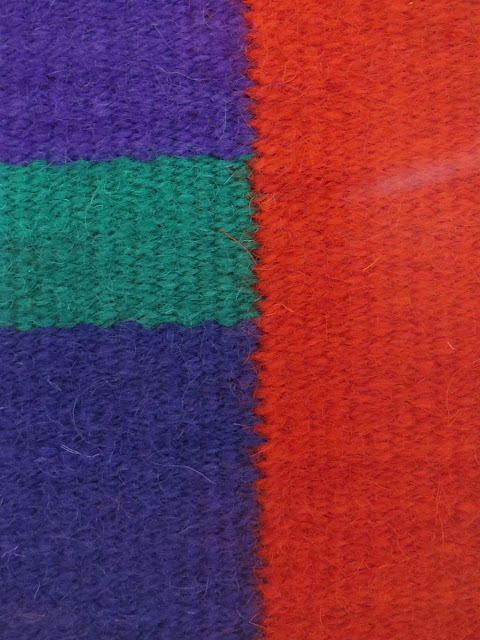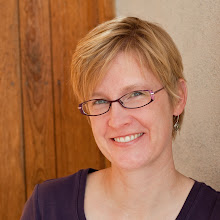James Koehler was a fast weaver. Anyone who weaves many hours a day is a fast weaver. But James had a real ability to focus. He could tune out everything and just weave. When there were students and apprentices in his studio as there often were, he was frequently pulled away from the loom to answer questions or supervise an apprentice's activity (I could wind balls of yarn like a champ, but when I got to work on re-hemming his tapestries, that made him nervous... which frankly made me nervous). But when we all went home at 5 pm, he worked. I frequently would return the next day to find that a piece that had several inches left to weave at 5 pm was off the loom. Sometimes he had even done the finishing and the tapestry was rolled up, ready for the photographer.
I talk some about why I weave on a floor loom and what I like about weaving all the way across using the beater on the loom. James wove much of his work all the way across. All the pieces like this Chief Blanket piece we are discussing in these videos were woven one pick at a time all the way across the loom. To do the joins he used in this piece, he had to weave it that way as everything was interlocked all the way across in some sections.
I weave all the way across whenever I can in part because I learned that way, but also because I use this join and a lot of irregular hatching to move color around. When using hatching, the color areas are interpenetrating and you can't weave one section before the other. If my color blends are going throughout much of the piece, I have to weave all the way across.
The other reason I talk about in this video is the nature of the fabric created. I don't see this reason talked about much at all among tapestry weavers. My tapestries certainly feel like a fabric. They might even make a nice blanket. They are fairly soft, thin and flexible. James' work felt similarly. When using the beater on the loom, it is possible to get a very even beat and to create a fabric that is not thicker in some areas than others which also means that it hangs very flat on the wall.
However, weaving all the way across is not possible all the time if you want to utilize the full range of tapestry's potential. James' Harmonic Oscillations pieces were woven somewhat differently. He wove up each curve and often outlined the edge of it before filling in to as close as flat as he could, beating with the beater bar on the loom, and then building up the next wave. I often weave up in shapes with the intention of outlining something or completing a section faster than another one. I like the flexibility of using a floor loom as it allows me to weave both ways in the same piece depending on the imagery I'm creating.
Just a note on what Barb says about an iron. Neither I nor James uses an iron on our tapestries. I use a steamer. For the most part, I don't want to squish the tapestry at all, I just want to use the steam to get a little shrinkage in the fibers to make the tapestry lie completely flat. James used a Jiffy steamer, but any clothes steamer that can be used horizontally (with the tapestry lying flat on a table not hanging on a hanger like a shirt would be) will work.
Below is the last of the five videos. See the links below if you missed the other four.
This is the fifth in a series of five posts about the James Koehler Denver Art Museum videos.
Here are links to the first four posts:
Part 1: Color
Part 2: Flat Tapestry
Part 3: Meditation
Part 4: Teacher
Here is one of the Harmonic Oscillation pieces. This one was woven sideways and each of the curves would have been woven up to the curve and then he put in an eccentric outline before continuing weaving straight across the grid. In this case you can see that the eccentric outlines were done with a lighter color which really accentuates the curves.
 |
| James Koehler, Harmonic Oscillation LXIII |




































